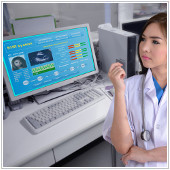 Medical history, vaccine status, lab test results, and other medical records are libraries unto themselves. Checking such files without the aid of computers can be cumbersome. Thanks to EHR, hospital staff can access these information with ease.
Medical history, vaccine status, lab test results, and other medical records are libraries unto themselves. Checking such files without the aid of computers can be cumbersome. Thanks to EHR, hospital staff can access these information with ease.
EHR stands for “Electronic Health Record,†and a lot can go into getting your practice ready for one of these data-sharing, network-connected, enterprise-wide information systems.
One of the primary concerns when setting up your EHR system is the computer hardware. You and your IT department — or a Managed Service Provider (MSP) with experience serving healthcare organizations — will need to assess how users can best connect to the system and then access and input information. Take a quick look at the 3 options for working in an EHR environment.
1. Desktops
The first option is to install desktop computers which will be fixed in one location, hardwired, and stationary. Many businesses have been using desktops for so long because they’re inexpensive, easy to install and get support, plus there’s a wide variety of vendors to choose from.
However, desktops take up more space than laptops, usually require the purchase of additional equipment in order to enable voice- or handwriting-recognition programs, and need to be set up in every room that requires access to the EHR software.
2. Laptops
The second option is to deploy laptops which give you and your staff more flexibility. The advantages include easy connection to both wireless and traditional local area networks, better maneuverability to allow patients to see on-screen information, and portability.
One distinct disadvantage of using laptops is that they can be quite heavy, especially when carried numerous times throughout the day. Also, in terms of maintenance, laptops repairs tend to be a bit more expensive, and may have to be sent to an off-site shop to be fixed.
3. Tablets
Offering even greater mobility than laptops are tablets, which are just as powerful as desktops and laptops but in a hip, hi-tech, handy portable form. With tablets, users can move from room to room easily, inputting data with a digital pen as if they were writing on a paper chart or dictating to an application that accurately transcribes speech directly to the patient’s EHR.
The shortcomings associated with using tablets in an EHR setting include the learning curve that comes with new technology, such as writing with a stylus; handwriting programs that may not recognize all medical terminology; touchscreens that are prone to scratches; and the additional costs from either repairing or protecting against damage.
An Electronic Health Records system can provide enormous benefits to your organization: easier data entry, quicker data recall, and improved data accuracy. So after you’ve gauged interest among your staff, created an EHR budget, organized an EHR leadership team, and established an implementation plan, it’s time to get down to the nitty-gritty of hardware.
If you’re unsure about which direction to go with your EHR workstations, give us a call today.



